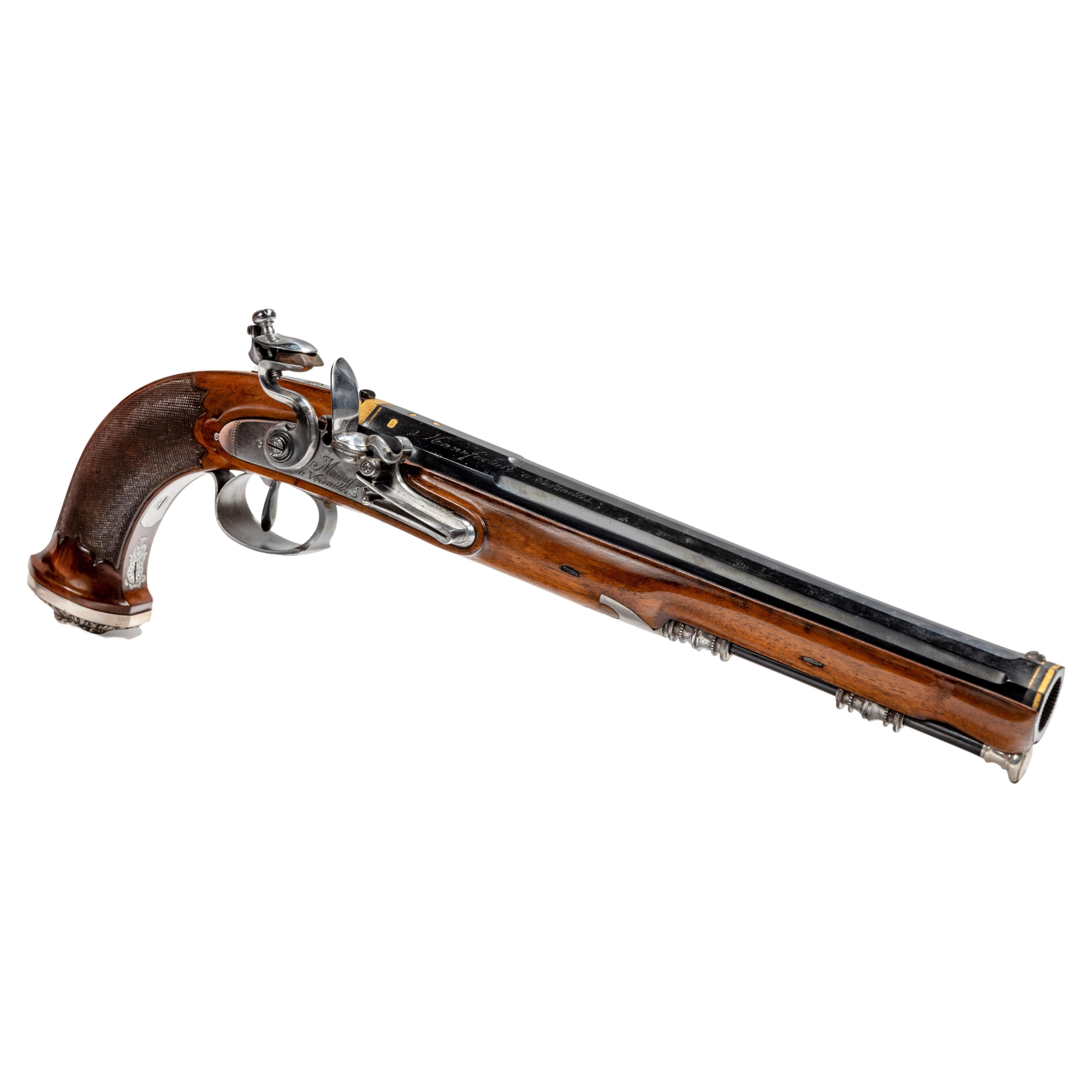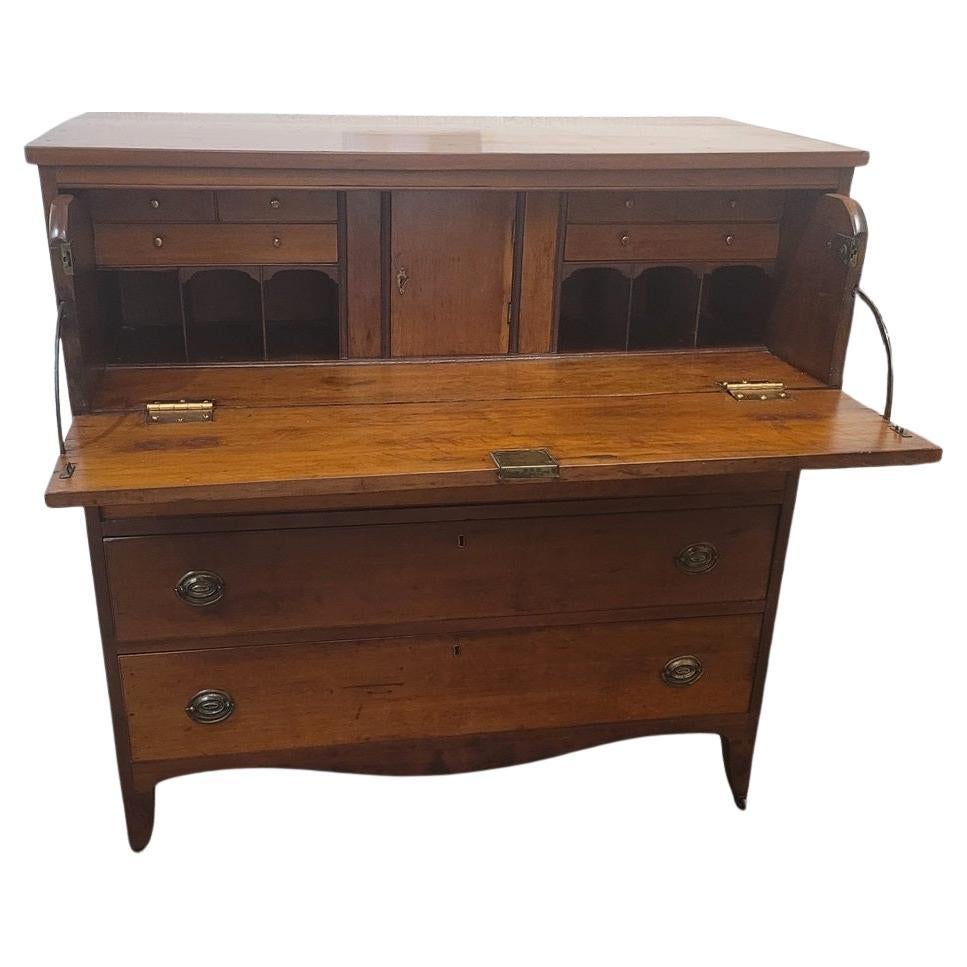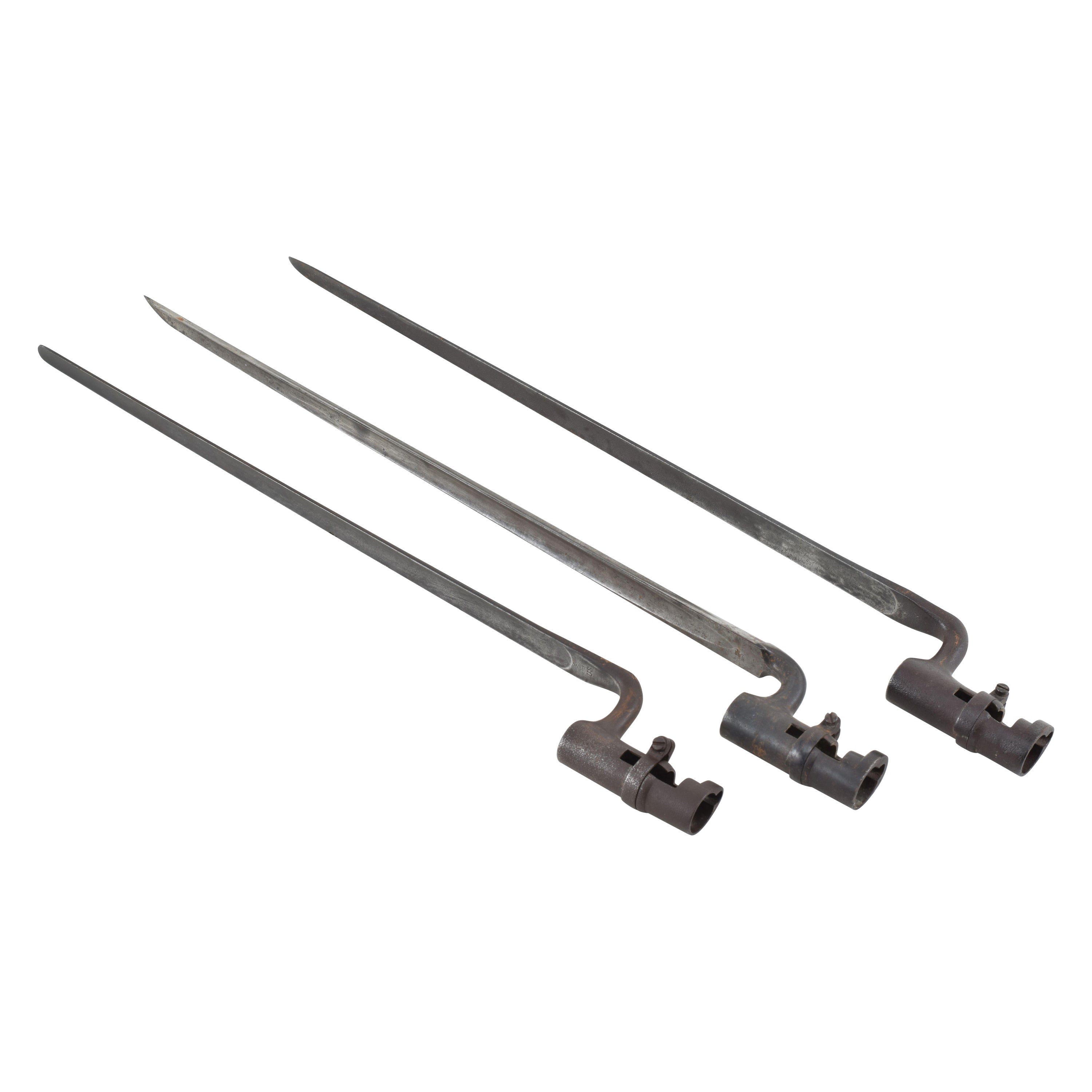Items Similar to Rare AMERICAN OFFICER'S SWORD - pre Civil War
Want more images or videos?
Request additional images or videos from the seller
1 of 7
Rare AMERICAN OFFICER'S SWORD - pre Civil War
About the Item
This is a very rare American Officer's sword that dates back to the period before the American Civil War.
The sword has a 79cm straight blade with a flat back, counter-edged and gutter with a patina and gilded engravings on the third. The initials of the manufacturer, "S H F" for Simon Helvig & Fils, (Simon Helvig & Sons) are present on the ricasso blade in a golden arc. The maker Simon Helvig and Fils was active in the Alsace region of France from about 1820 – 1840. Many of his swords were exported to the US by his agents.
The brass frame is chiseled with an eagle head pommel and a melon slice shaped bone grip. The guard has a branch with an eagle behind a federal shield. There is no play at the hilt, and there is no play between the blade and the handle.
The scabbard is entirely made of gilded and bare brass, featuring a shield-shaped button and two brass bail pins. There is a small chip located 25cm from the tip.
The total length of the sword is 94cm, and it weighs 780g with the scabbard included.
- Dimensions:Height: 37.01 in (94 cm)Width: 4.73 in (12 cm)Depth: 3.94 in (10 cm)
- Materials and Techniques:
- Place of Origin:
- Period:
- Date of Manufacture:1820
- Condition:Wear consistent with age and use.
- Seller Location:TEYJAT, FR
- Reference Number:
About the Seller
4.7
Platinum Seller
These expertly vetted sellers are 1stDibs' most experienced sellers and are rated highest by our customers.
Established in 2009
1stDibs seller since 2023
15 sales on 1stDibs
Typical response time: <1 hour
- ShippingRetrieving quote...Ships From: TEYJAT, France
- Return PolicyA return for this item may be initiated within 14 days of delivery.
More From This SellerView All
- RARE FRENCH SEAMAN'S TAR HAT - early 19th century.Located in TEYJAT, FRRARE FRENCH SEAMAN'S HAT Formed from boiled cardboard and bathed in tar to make it waterproof, this is a very rare exemple from French maritime history. The hat has a tin tricolou...Category
Antique Early 19th Century French Arms, Armor and Weapons
MaterialsPaper
- AMERICAN THEMED Romantic Dagger - early to mid 19th century - SpanishLocated in TEYJAT, FRSUPERB AMERICAN THEMED ROMATIC DAGGER : EARLY TO MID 19THE CENTURY - Spanish, with 14.75cm flattened diamond shaped tapering blade and heavy cast bronze grip comprising a pair of opposing dogs head quillions surmounted by a frontiersman in traditional dress of the early 19th century carrying a flintlock long rifle, associated tasselled bag and powder horn with an animal fur skin...Category
Antique Early 19th Century Spanish Arms, Armor and Weapons
MaterialsBronze
- Rare SWISS MODEL 1830 BELL TOP SHAKO Helmet to Jaeger RegimentLocated in TEYJAT, FRRARE SWISS MODEL 1830 BELL TOP SHAKO TO A JAGER REGIMENT Constructed of felt body with solid leather peak, band and top (misshaped), white metal chin scales , red cockade with Swis...Category
Antique Early 19th Century Swiss Arms, Armor and Weapons
MaterialsLeather, Textile
- SAINT PAUL: Statuette in carved and gilded polychrome wood Late 18th centuryLocated in TEYJAT, FRSAINT PAUL: Statuette in carved and gilded polychrome wood, Late 18th century. Saint Paul, also known as the Apostle Paul, was an important figure in early Christianity and is often...Category
Antique Late 18th Century European Neoclassical Religious Items
MaterialsWood
- TOPPAI JINGASA EDO PERIOD - 18-19th Century - JapanLocated in TEYJAT, FRThis is a custom-made historical Japanese hat known as Jinggasa, worn by samurai during the Edo period (1603-1868), around the 18th to 19th century. Within the category of Jingasa, t...Category
Antique Late 18th Century Japanese Edo Arms, Armor and Weapons
MaterialsLeather, Textile, Paper
- Vintage reproduction gauntlet / armour, early 20th century.Located in TEYJAT, FRVintage reproduction gauntlet, early 20th century. A left handed gauntlet with all fingers and thumb present, jointed and riveted with leather in...Category
Antique Early 19th Century Arms, Armor and Weapons
MaterialsMetal
You May Also Like
- Boutet, General Officer's GunBy H. BoutetLocated in Paris, FRNicolas Boutet (1761-1833) Pistolet d’Officer Général Platine à corps plat marquée « Manuf a Versailles », chien à corps plat à col de cygne, toutes...Category
Antique Early 19th Century French Arms, Armor and Weapons
MaterialsBronze, Stainless Steel
- American Hepplewhite Virginian Secretary Chest with Civil War ProvenanceBy George HepplewhiteLocated in Dallas, TXPRESENTING a FANTASTIC and HISTORIC Early 19C American Hepplewhite Virginian Secretary Chest with OUTSTANDING Provenance. This Secretary Chest was made in Virginia in the Early 19th Century, circa 1810. It is made of cherry, walnut and maple and is most definitely in the Hepplewhite Style of the period, with it’s original Hepplewhite brass drawer pulls. IT IS A REALLY INTRIGUING AND HISTORIC PIECE, ESPECIALLY, WHEN VIEWED IN CONTEXT WITH IT”S AMAZING PROVENANCE! This piece was originally owned by Major William Alexander Obenchain who ‘hailed’ from the State of Virginia. He was an engineer and was in the Virginia Corps of Engineers during the Civil War and served on General Robert E. Lee’s staff. It was acquired by him before the Civil War and we believe that this piece was on campaign with him during the War. We know for a fact that he fought at the Richmond Campaign in 1864, as we have, in our Collection, his original Field Map for that Campaign which ended the War. It has remained in family ownership ever since. It has come directly from the Family Estate, together with other VERY IMPORTANT items belonging to Major Obenchain and other IMPORTANT items that belonged to his wife, Eliza Calvert Hall-Obenchain. ALL these items contained in the Collection, are listed/posted individually on our Website. The top drawer is on retractable curved side hinge supports and pulls outwards and drops to reveal a secretary and writing area. The Bureau/Secretary Gallery has 6 drawers and 6 cubbies, a central tabernacle door with another drawer and 2 cubbies and this is flanked by 2 secret pull out compartments. The central tabernacle door has it’s original key and working lock. Closed, it is almost ‘flush’ like the rest of the drawers, with some very minor bowing through age. The 3 drawers underneath are graduated in size and it ends with a serpentine shaped base and sits on four hand carved legs with original metal casters, marked ‘Universal 3’. It has it’s original brasses and hardware throughout, save the addition to 2 contemporary replacement brass hinges to the drop down desk front, as the original hinges were broken, could not be repaired and were not supporting the weight of the drop down leaf. Some minor repairs but not noticeable. Otherwise, the piece is in it’s entirely, ORIGINAL condition! What makes this piece even MORE INTRIGUING and APPEALING HISTORICALLY, are the 2 ‘historic’ circular holes on the piece:- (1) in the back of the piece as seen in the photos. This hole is not symmetrical or fully round and appears to serve no purpose to the piece whatsoever. Sometimes, pieces have holes for wiring for lighting, put in them over the years, but this one never had such lighting or, indeed, any such explanation for this hole, AND (2) the rear hole is replicated, in the corner portion of the bottom drawer and someone (a very long time ago) has used a tin can top, to cover the hole in the back of the drawer. The tin can top is period to the Civil War Era and is embossed “Minimum Volume 1 Pint”. Our conclusion, is that (whilst we are, by no means ballistic experts) that these holes were created by musket balls, fired during one of the Major’s campaigns in the Civil War. It is entirely conceivable that this piece, being strapped into a covered wagon for carriage, would have been on it’s side. We are of the opinion that both holes, were caused or created by a musket ball entered the chest trough the base and back. We also believe that ‘the Major’, used what he had at his disposal on the battlefield, namely, a tin can lid to repair the hole in the drawer. SO THIS PIECE IS A VERY SPECIAL PIECE OF US HISTORY, INDEED! NOT ONLY IS IT AN EARLY 19th CENTURY AMERICAN PIECE, WITH A CONNECTION TO THE STATE OF VIRGINIA, THE CIVIL WAR, HISTORIC & IMPORTANT FIGURES IN THAT WAR AND IMPECCABLE PROVENANCE AND HISTORY! IT IS TRULY UNIQUE! William Alexander Obenchain. Born April 27, 1841 at Buchanan, Botetourt Co., Virginia. Parents: Thomas Jefferson Obenchain and Elizabeth Ann Sweetland. Entered VMI on July 18, 1859 as a member of the VMI (Virginia Military Institute...Category
Antique Early 19th Century American American Classical Historical Memora...
MaterialsBrass
- 36 Star American Flag, Civil War Era, Nevada StatehoodLocated in York County, PA36 Stars In The "Great Star" Or "Great Luminary" Pattern On A Civil War Era Flag With A Dusty Blue Canton And A Section Of One Stripe Souvenired, 1864-67, Nevada Statehood 36 star American national flag of the Civil War era, entirely hand-sewn and with some rare and beautiful features. The stars are arranged in a rendition of what is known as the Great Star or Great Luminary configuration, a large star made out of smaller stars. With no official star pattern before 1912, their design was left up to the artistic liberties of the flag-maker. Strikingly visual, the Great Star is both scarce and coveted by collectors. The 36th state, Nevada, entered the Union during the Civil War on October 31st, 1864. The last Confederate general surrendered on May 26th, 1865. The 36 star flag became official on July 4th of that year, but makers of printed flags would have begun adding a 36th star to their flags in 1864, even before the addition of the new state occurred. Lincoln pushed Nevada through just 8 days before the November election. Nevada’s wealth in silver was attractive to a nation struggling with the debts of war and increased support for the Republican ticket. The 36 star flag was replaced by the 37 star flag in 1867, with the addition of Nebraska. Adding to the flag's appeal is its small scale across those with of piece-and-sewn construction. During the 19th century, sewn flags (as opposed to those that were printed on cloth) were typically eight feet long and larger. This is because they were important in their function as signals, meaning that they needed to be seen and recognized from great distance. A flag that was six feet in length was considered small and production of flags smaller than this was extremely limited. Even infantry battle flags were approximately six by six and-one-half feet, about the size of an average quilt of the same period. As time passed, circumstances changed and sewn flags began to find more of a decorative purpose. Smaller flags are more scarce and far easier to frame and display. The Great Star configuration appears to have come about shortly after the War of 1812, when Congressman Peter Wendover of New York requested that Captain Samuel Reid, a War of 1812 naval hero, create a new design that would become the third official format of the Stars & Stripes. A recipient of the Congressional Medal of Honor, Reid became harbor master of New York following the war. During his lifetime, he created many innovations in signal use, including a system that could actually send messages from New York to New Orleans by sea in just two hours. Use as a Naval signal had been the primary reason for the initial creation of an American national flag in 1777, but since there was no official star design, the appearance of our flag varied greatly. Reid’s primary concern centered on both consistency and ease of recognition. His hope was as more and more states joined the Union and more and more stars were added to the flag, that it would remain easily identified on the open seas. In 1818, Reid suggested to Congress that the number of stripes permanently return to 13 (reduced from 15) and that the stars be grouped into the shape of one large star. Reid’s proposal would have kept the star constellation in roughly the same format, in a pattern that could be quickly identified through a spyglass as the number of states grew. His concept for the stripes was ultimately accepted, but his advice on the star pattern was rejected by President James Monroe, due to the increased cost of arranging the stars in what would become known as the “Great Star”, “Great Flower”, or “Great Luminary” pattern. Monroe probably didn’t wish to impose this cost on either the government or civilians, so he suggested a simple pattern of justified rows. Never-the-less, the Great Star was produced by anyone willing to make it and its rarity today, along with its beauty, has driven the desirability of American flags with this configuration. The canton and stripes of the flag are made of fine merino wool. Note how the canton has faded to a dusty seafoam blue, which is endearingly attractive. The stars of the flag are hand-sewn and single-appliquéd. This means that they were applied to one side of the canton, then the blue fabric was cut from behind each star, folded over, and under-hemmed, so that one star could be viewed on both sides of the flag. I always find single-appliquéd stars more interesting, not only because they are evidence of a more difficult level of seam-work and stitching, but also because they are more visually intriguing. The two visible rows of hand-stitching emphasize their hand-sewn construction, which is one reason why flags with single-appliquéd stars often appeal to connoisseurs of early American textiles...Category
Antique 1860s American Political and Patriotic Memorabilia
MaterialsWool
- Civil War Socket BayonetsLocated in Norton, MAThree Socket Bayonets. One is a P-53 Civil War era marked "DEAKIN" and has a crown over 53, one is a "US" stamped dull tip, and the last is unmarked or stamped.Category
Antique 19th Century American Arms, Armor and Weapons
MaterialsMetal
- 19th Century French First Officer’s Uniform Red EpaulettesLocated in Chillerton, Isle of Wight19th Century French First Officer’s Uniform Red Epaulettes Good pair of French Officers Epaulettes made in Red Silk and lined in black velvet, the f...Category
Antique Late 19th Century Federal Historical Memorabilia
MaterialsWool
- U.S. Army officer's pocket compass during WW1 signed WITTNAUERLocated in Milan, ITU.S. Army officer's pocket compass during World War I made of chrome-plated brass in the shape of an onion clock, signed WITTNAUER. The compass is equipped with a snap-lock cover wi...Category
Vintage 1910s Scientific Instruments
MaterialsBrass
Recently Viewed
View AllMore Ways To Browse
Hunting Arms
English Cavalry Sword
Antique Rifle Rack
Framed British Cartridges
Omani Dagger
Royal Bodyguard Archers
Spanish Arquebus
Vintage Army Ammo Box
Vintage Wooden Ammunition Box
Walking Cane Sword
Weapon Cane
William Fiske
Antique Copper Powder Horn
Antique Handcuff Key
Antique Handcuff
Edo Period Mempo
Full Horn Walking Canes
Hizen Katana





